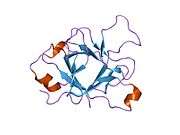Interleukin 36 receptor antagonist
| View/Edit Human | View/Edit Mouse |
Interleukin 36 receptor antagonist is a protein that in humans is encoded by the IL36RN gene. It was previously named Interleukin-1 family member 5 (IL1F5).[3][4][5][6]
The protein encoded by this gene is a member of the interleukin 1 cytokine family. This cytokine was shown to specifically inhibit the activation of NF-kappaB induced by interleukin 1 family, member 6 (IL1F6). This gene and eight other interleukin 1 family genes form a cytokine gene cluster on chromosome 2. Two alternatively spliced transcript variants encoding the same protein have been reported.[6]
References
- ↑ "Human PubMed Reference:".
- ↑ "Mouse PubMed Reference:".
- ↑ Smith DE, Renshaw BR, Ketchem RR, Kubin M, Garka KE, Sims JE (Feb 2000). "Four new members expand the interleukin-1 superfamily". J Biol Chem. 275 (2): 1169–75. doi:10.1074/jbc.275.2.1169. PMID 10625660.
- ↑ Mulero JJ, Pace AM, Nelken ST, Loeb DB, Correa TR, Drmanac R, Ford JE (Nov 1999). "IL1HY1: A novel interleukin-1 receptor antagonist gene". Biochem Biophys Res Commun. 263 (3): 702–6. doi:10.1006/bbrc.1999.1440. PMID 10512743.
- ↑ Sims JE, Nicklin MJ, Bazan JF, Barton JL, Busfield SJ, Ford JE, Kastelein RA, Kumar S, Lin H, Mulero JJ, Pan J, Pan Y, Smith DE, Young PR (Sep 2001). "A new nomenclature for IL-1-family genes". Trends Immunol. 22 (10): 536–7. doi:10.1016/S1471-4906(01)02040-3. PMID 11574262.
- 1 2 "Entrez Gene: IL36RN interleukin 36 receptor antagonist".
Further reading
- Nicklin MJ, Weith A, Duff GW (1994). "A physical map of the region encompassing the human interleukin-1 alpha, interleukin-1 beta, and interleukin-1 receptor antagonist genes". Genomics. 19 (2): 382–4. doi:10.1006/geno.1994.1076. PMID 8188271.
- Nothwang HG, Strahm B, Denich D, et al. (1997). "Molecular cloning of the interleukin-1 gene cluster: construction of an integrated YAC/PAC contig and a partial transcriptional map in the region of chromosome 2q13". Genomics. 41 (3): 370–8. doi:10.1006/geno.1997.4654. PMID 9169134.
- Kumar S, McDonnell PC, Lehr R, et al. (2000). "Identification and initial characterization of four novel members of the interleukin-1 family". J. Biol. Chem. 275 (14): 10308–14. doi:10.1074/jbc.275.14.10308. PMID 10744718.
- Busfield SJ, Comrack CA, Yu G, et al. (2000). "Identification and gene organization of three novel members of the IL-1 family on human chromosome 2". Genomics. 66 (2): 213–6. doi:10.1006/geno.2000.6184. PMID 10860666.
- Mulero JJ, Nelken ST, Ford JE (2000). "Organization of the human interleukin-1 receptor antagonist gene IL1HY1". Immunogenetics. 51 (6): 425–8. doi:10.1007/s002510050640. PMID 10866108.
- Barton JL, Herbst R, Bosisio D, et al. (2001). "A tissue specific IL-1 receptor antagonist homolog from the IL-1 cluster lacks IL-1, IL-1ra, IL-18 and IL-18 antagonist activities". Eur. J. Immunol. 30 (11): 3299–308. doi:10.1002/1521-4141(200011)30:11<3299::AID-IMMU3299>3.0.CO;2-S. PMID 11093146.
- Pan G, Risser P, Mao W, et al. (2001). "IL-1H, an interleukin 1-related protein that binds IL-18 receptor/IL-1Rrp". Cytokine. 13 (1): 1–7. doi:10.1006/cyto.2000.0799. PMID 11145836.
- Lin H, Ho AS, Haley-Vicente D, et al. (2001). "Cloning and characterization of IL-1HY2, a novel interleukin-1 family member". J. Biol. Chem. 276 (23): 20597–602. doi:10.1074/jbc.M010095200. PMID 11278614.
- Debets R, Timans JC, Homey B, et al. (2001). "Two novel IL-1 family members, IL-1 delta and IL-1 epsilon, function as an antagonist and agonist of NF-kappa B activation through the orphan IL-1 receptor-related protein 2". J. Immunol. 167 (3): 1440–6. doi:10.4049/jimmunol.167.3.1440. PMID 11466363.
- Tazi-Ahnini R, Cox A, McDonagh AJ, et al. (2002). "Genetic analysis of the interleukin-1 receptor antagonist and its homologue IL-1L1 in alopecia areata: strong severity association and possible gene interaction". Eur. J. Immunogenet. 29 (1): 25–30. doi:10.1046/j.1365-2370.2002.00271.x. PMID 11841485.
- Nicklin MJ, Barton JL, Nguyen M, et al. (2002). "A sequence-based map of the nine genes of the human interleukin-1 cluster". Genomics. 79 (5): 718–25. doi:10.1006/geno.2002.6751. PMID 11991722.
- Strausberg RL, Feingold EA, Grouse LH, et al. (2003). "Generation and initial analysis of more than 15,000 full-length human and mouse cDNA sequences". Proc. Natl. Acad. Sci. U.S.A. 99 (26): 16899–903. doi:10.1073/pnas.242603899. PMC 139241
 . PMID 12477932.
. PMID 12477932. - Clark HF, Gurney AL, Abaya E, et al. (2003). "The Secreted Protein Discovery Initiative (SPDI), a Large-Scale Effort to Identify Novel Human Secreted and Transmembrane Proteins: A Bioinformatics Assessment". Genome Res. 13 (10): 2265–70. doi:10.1101/gr.1293003. PMC 403697
 . PMID 12975309.
. PMID 12975309. - Zee RY, Fernandez-Ortiz A, Macaya C, et al. (2004). "IL-1 cluster genes and occurrence of post-percutaneous transluminal coronary angioplasty restenosis: a prospective, angiography-based evaluation". Atherosclerosis. 171 (2): 259–64. doi:10.1016/S0021-9150(03)00294-6. PMID 14644395.
- Ota T, Suzuki Y, Nishikawa T, et al. (2004). "Complete sequencing and characterization of 21,243 full-length human cDNAs". Nat. Genet. 36 (1): 40–5. doi:10.1038/ng1285. PMID 14702039.
- Colland F, Jacq X, Trouplin V, et al. (2004). "Functional Proteomics Mapping of a Human Signaling Pathway". Genome Res. 14 (7): 1324–32. doi:10.1101/gr.2334104. PMC 442148
 . PMID 15231748.
. PMID 15231748. - Gerhard DS, Wagner L, Feingold EA, et al. (2004). "The Status, Quality, and Expansion of the NIH Full-Length cDNA Project: The Mammalian Gene Collection (MGC)". Genome Res. 14 (10B): 2121–7. doi:10.1101/gr.2596504. PMC 528928
 . PMID 15489334.
. PMID 15489334.
This article is issued from Wikipedia - version of the 11/2/2016. The text is available under the Creative Commons Attribution/Share Alike but additional terms may apply for the media files.


